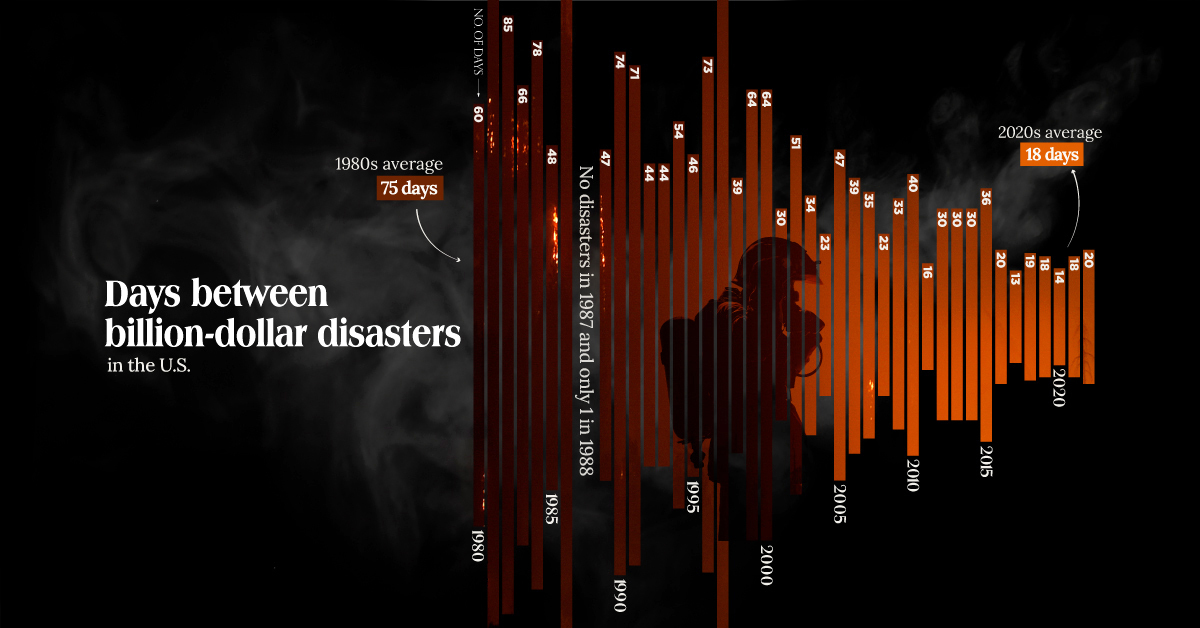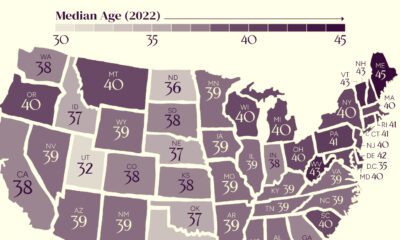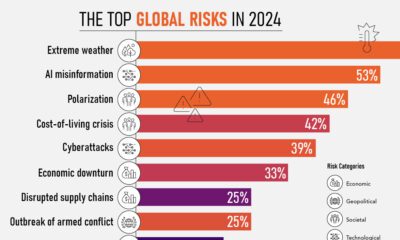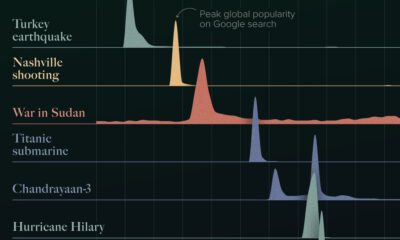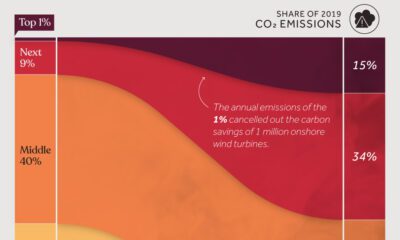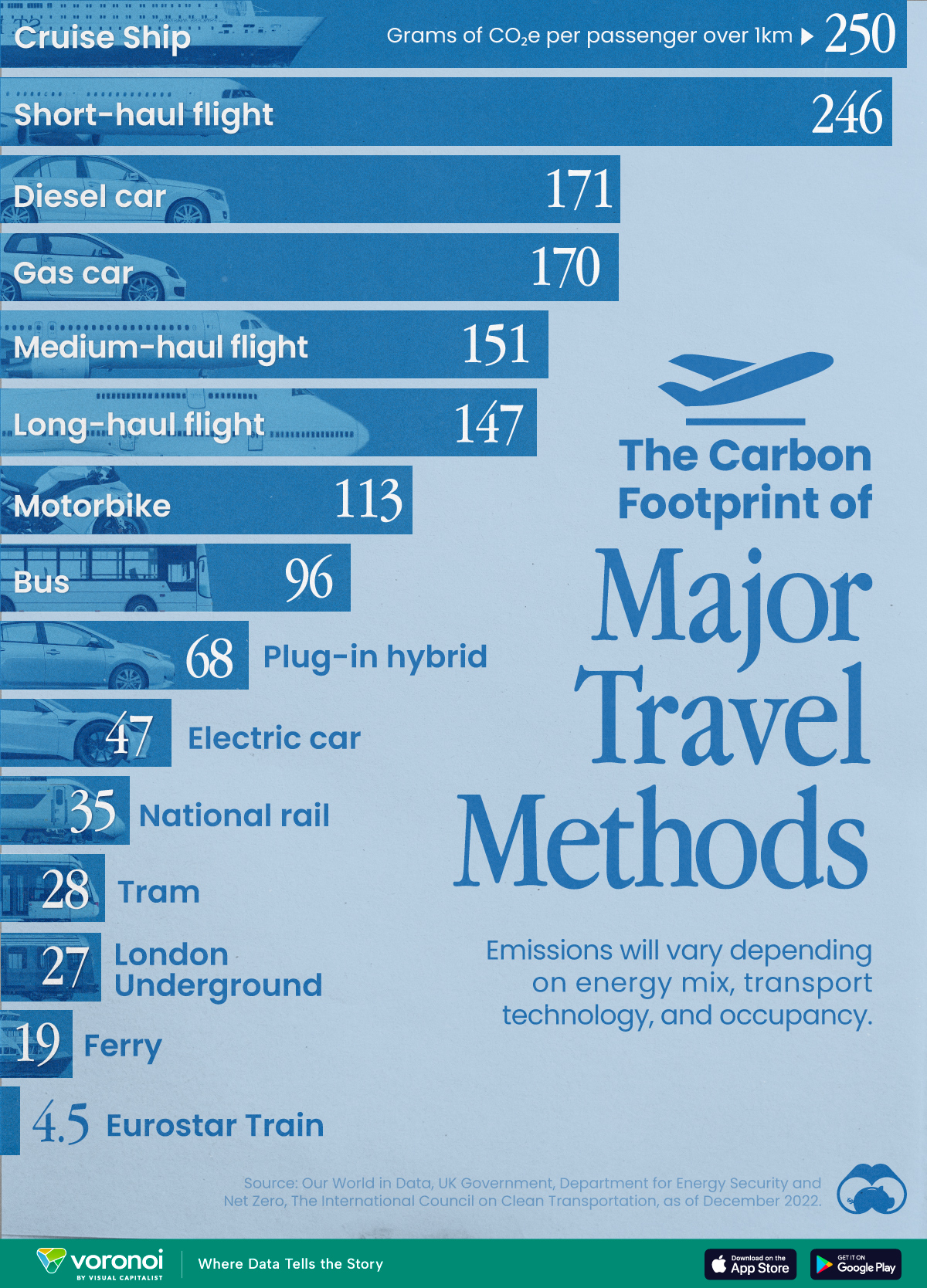Green
The Frequency of Billion-Dollar Disasters in the U.S.
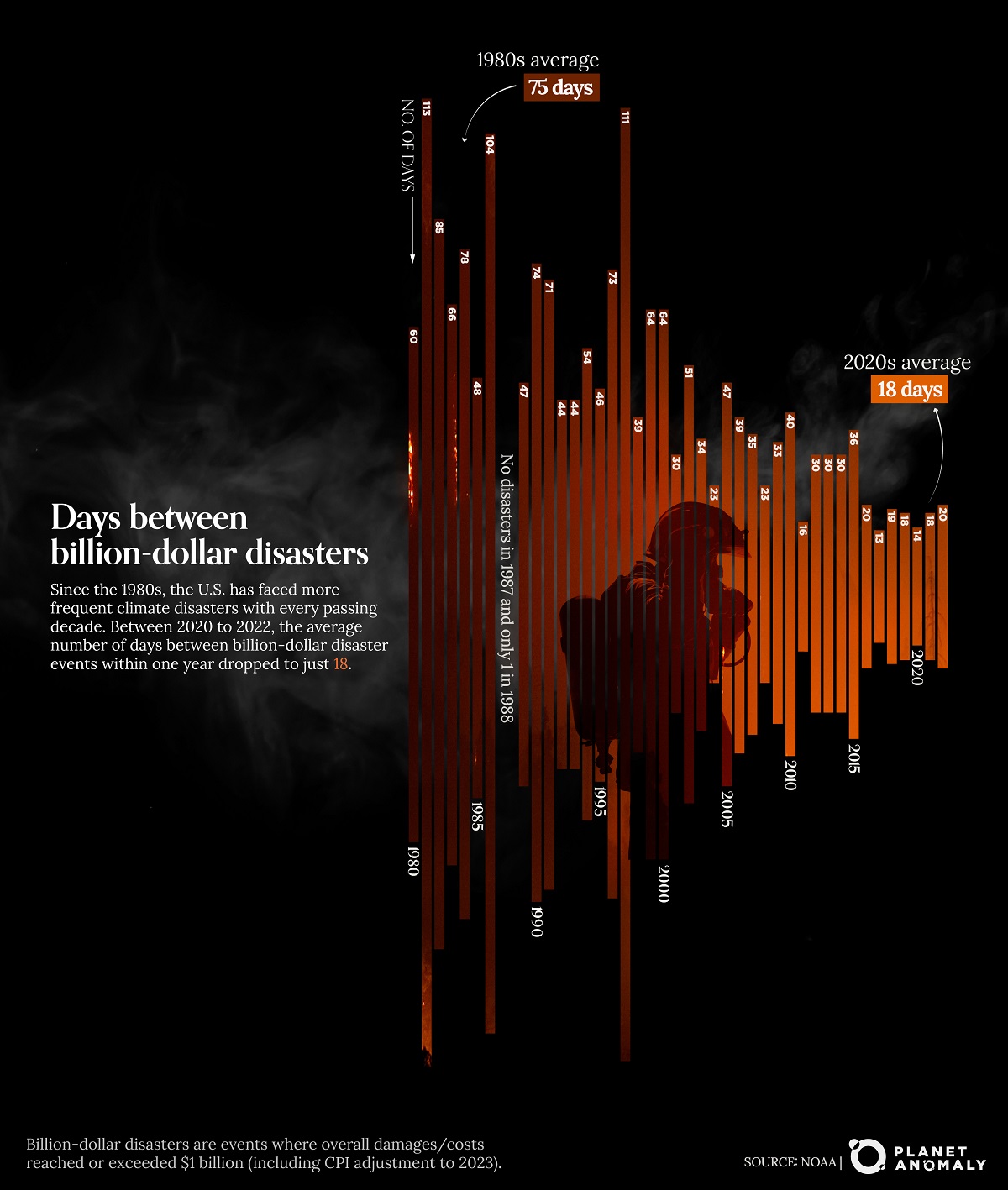
Frequency of Billion-Dollar Disasters in the U.S.
Wildfires on the Hawaiian island of Maui have had devastating effects on people, towns, and nature, and the final cost is nowhere near tallied. They are the latest of many climate disasters in the U.S.—and data shows that their frequency has been increasing.
These graphics from Planet Anomaly use tracking data from the National Oceanic and Atmospheric Administration (NOAA) to show the average number of days between billion-dollar weather disasters in the U.S. from 1980 to 2022.
Methodology
NOAA’s database examines billion-dollar weather and climate disasters in America. Total associated damages and costs for each event are adjusted for inflation using the 2023 Consumer Price Index (CPI).
Disasters are categorized as one of seven different types:
- Drought: Prolonged dry spells resulting in water shortages and reduced soil moisture.
- Flooding: Overflow of water inundating land usually due to intense rainfall or melting snow.
- Tropical Cyclone: Intense rotating storm systems known as hurricanes.
- Severe Storm: Includes windstorms and tornadoes, hail, lightning, and heavy precipitation.
- Winter Storm: Heavy snow, freezing rain, and icy conditions impacting transportation and infrastructure.
- Wildfire: Uncontrolled fires consuming vast areas of forests and vegetation.
- Freezes: Sub-zero temperatures damaging crops and infrastructure, such as pipes or energy lines.
The average days between billion-dollar disasters are calculated from the start dates of adjacent events within a single year.
Days Between Billion-Dollar Disasters in the U.S. (1980‒2022)
Between 1980 and 2022, there were 155 total disasters in the U.S. that cost more than a billion dollars in damages when adjusted for inflation.
And when looking at the average number of days between these billion-dollar events within each year, we can see the decades becoming more and more costly:
| Year | Avg. Days Between Disasters |
|---|---|
| 1980 | 60 |
| 1981 | 113 |
| 1982 | 85 |
| 1983 | 66 |
| 1984 | 78 |
| 1985 | 48 |
| 1986 | 104 |
| 1987 | N/A |
| 1988 | N/A |
| 1989 | 47 |
| 1990 | 74 |
| 1991 | 71 |
| 1992 | 44 |
| 1993 | 44 |
| 1994 | 54 |
| 1995 | 46 |
| 1996 | 73 |
| 1997 | 111 |
| 1998 | 39 |
| 1999 | 64 |
| 2000 | 64 |
| 2001 | 30 |
| 2002 | 51 |
| 2003 | 34 |
| 2004 | 23 |
| 2005 | 47 |
| 2006 | 39 |
| 2007 | 35 |
| 2008 | 23 |
| 2009 | 33 |
| 2010 | 40 |
| 2011 | 16 |
| 2012 | 30 |
| 2013 | 30 |
| 2014 | 30 |
| 2015 | 36 |
| 2016 | 20 |
| 2017 | 13 |
| 2018 | 19 |
| 2019 | 18 |
| 2020 | 14 |
| 2021 | 18 |
| 2022 | 20 |
Back in the early 1980s, the average interval between these major disasters (within each year) was 75 days. Even more starkly, 1987 had no climate disasters that topped $1 billion in damages, while 1988 only had one.
Fast forward to 2022, and that average window has drastically reduced to a mere 20 days between billion-dollar disasters in the United States.
Breaking Down Billion-Dollar Disasters by Type
Of the 155 disasters tracked through 2022, the majority have been in the form of severe storms including tornadoes, windstorms, and thunderstorms.
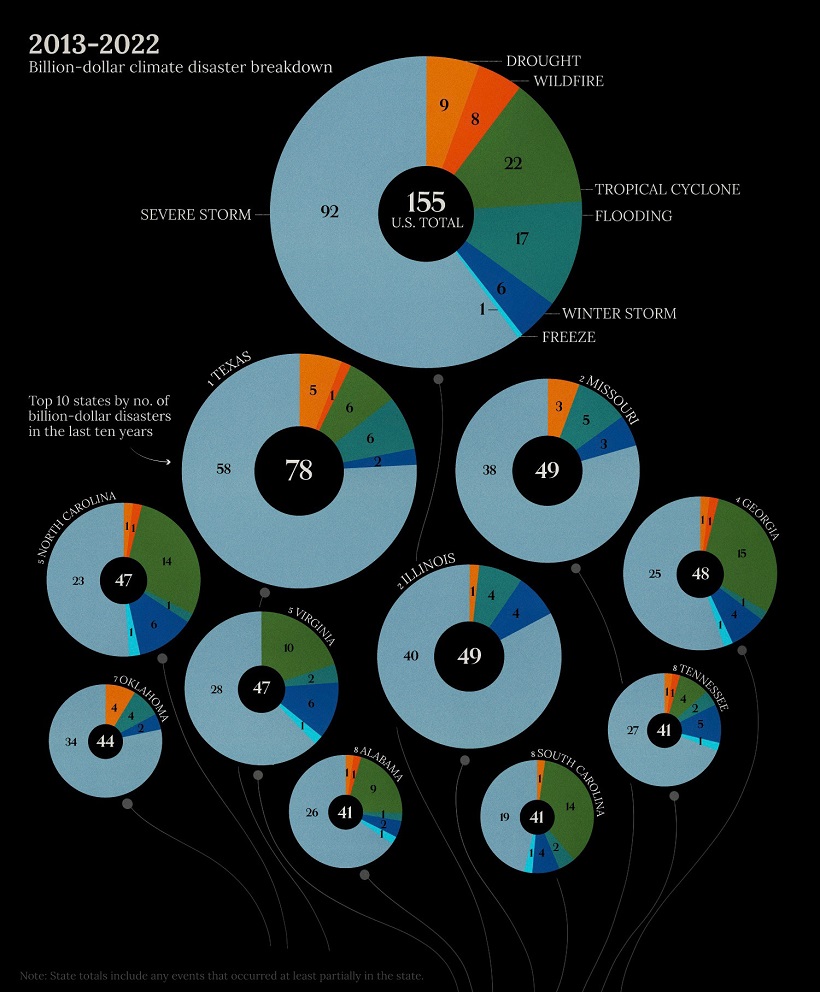
The worst severe storms include an outbreak of tornadoes in April 2011 across many central and southern states, with an estimated 343 tornadoes causing a total of $14 billion in CPI-adjusted damages. In August 2020, a powerful derecho—a widespread and intense windstorm characterized by straight-line winds—devastated millions of acres of crops across the Midwest and caused $13 billion in adjusted damages.
But the most expensive disasters so far have been hurricanes. Eight hurricanes top the inflation-adjusted damages charts, with Hurricane Katrina’s unprecedented devastation in 2005 leading with a staggering $194 billion.
Will the U.S. be prepared for more costly disasters going forward? And will climate change continue to accelerate the pace of weather disasters in the U.S. even more?

This article was published as a part of Visual Capitalist's Creator Program, which features data-driven visuals from some of our favorite Creators around the world.
Green
The Carbon Footprint of Major Travel Methods
Going on a cruise ship and flying domestically are the most carbon-intensive travel methods.
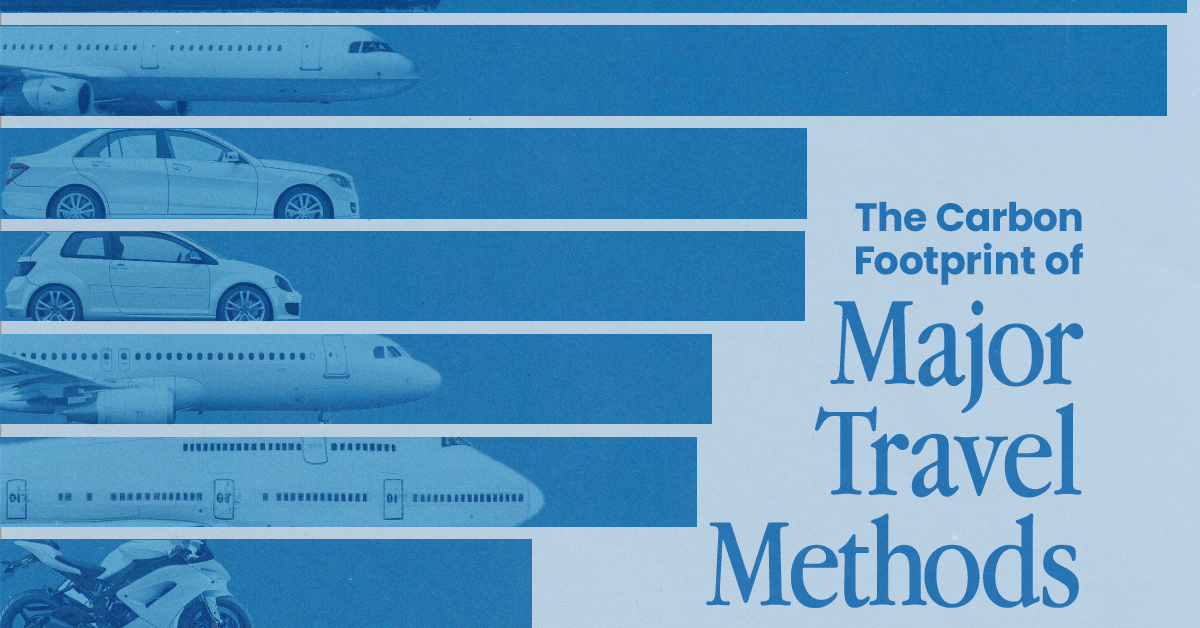
The Carbon Footprint of Major Travel Methods
This was originally posted on our Voronoi app. Download the app for free on iOS or Android and discover incredible data-driven charts from a variety of trusted sources.
Did you know that transport accounts for nearly one-quarter of global energy-related carbon dioxide (CO₂) emissions?
This graphic illustrates the carbon footprints of major travel methods measured in grams of carbon dioxide equivalent (CO₂e) emitted per person to travel one kilometer. This includes both CO₂ and other greenhouse gases.
Data is sourced from Our World in Data, the UK Government’s Department for Energy Security and Net Zero, and The International Council on Clean Transportation, as of December 2022.
These figures should be interpreted as approximations, rather than exact numbers. There are many variables at play that determine the actual carbon footprint in any individual case, including vehicle type or model, occupancy, energy mix, and even weather.
Cruise Ships are the Most Carbon-Intensive Travel Method
According to these estimates, taking a cruise ship, flying domestically, and driving alone are some of the most carbon-intensive travel methods.
Cruise ships typically use heavy fuel oil, which is high in carbon content. The average cruise ship weighs between 70,000 to 180,000 metric tons, meaning they require large engines to get moving.
These massive vessels must also generate power for onboard amenities such as lighting, air conditioning, and entertainment systems.
Short-haul flights are also considered carbon-intensive due to the significant amount of fuel consumed during initial takeoff and climbing altitude, relative to a lower amount of cruising.
| Transportation method | CO₂ equivalent emissions per passenger km |
|---|---|
| Cruise Ship | 250 |
| Short-haul flight (i.e. within a U.S. state or European country) | 246 |
| Diesel car | 171 |
| Gas car | 170 |
| Medium-haul flight (i.e. international travel within Europe, or between U.S. states) | 151 |
| Long-haul flight (over 3,700 km, about the distance from LA to NY) | 147 |
| Motorbike | 113 |
| Bus (average) | 96 |
| Plug-in hybrid | 68 |
| Electric car | 47 |
| National rail | 35 |
| Tram | 28 |
| London Underground | 27 |
| Ferry (foot passenger) | 19 |
| Eurostar (International rail) | 4.5 |
Are EVs Greener?
Many experts agree that EVs produce a lower carbon footprint over time versus traditional internal combustion engine (ICE) vehicles.
However, the batteries in electric vehicles charge on the power that comes straight off the electrical grid—which in many places may be powered by fossil fuels. For that reason, the carbon footprint of an EV will depend largely on the blend of electricity sources used for charging.
There are also questions about how energy-intensive it is to build EVs compared to a comparable ICE vehicle.
-

 Debt1 week ago
Debt1 week agoHow Debt-to-GDP Ratios Have Changed Since 2000
-

 Markets2 weeks ago
Markets2 weeks agoRanked: The World’s Top Flight Routes, by Revenue
-

 Countries2 weeks ago
Countries2 weeks agoPopulation Projections: The World’s 6 Largest Countries in 2075
-

 Markets2 weeks ago
Markets2 weeks agoThe Top 10 States by Real GDP Growth in 2023
-

 Demographics2 weeks ago
Demographics2 weeks agoThe Smallest Gender Wage Gaps in OECD Countries
-

 United States2 weeks ago
United States2 weeks agoWhere U.S. Inflation Hit the Hardest in March 2024
-

 Green2 weeks ago
Green2 weeks agoTop Countries By Forest Growth Since 2001
-

 United States2 weeks ago
United States2 weeks agoRanked: The Largest U.S. Corporations by Number of Employees

